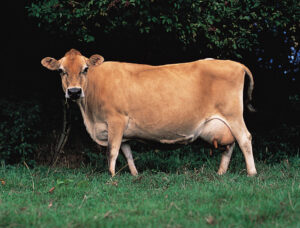Jersey cows are a popular breed of dairy cattle known for their unique characteristics and exceptional milk production. With their distinct appearance and rich milk, Jersey cows have become a favorite among farmers and consumers alike. In this article, we will explore the various characteristics of Jersey dairy cows, their history, physical attributes, milk production, and the benefits they offer to the dairy industry.
The History of Jersey Cows
Jersey cows trace their origins back to the British Channel Island of Jersey, from which they derive their name. The breed has a long and fascinating history, dating back to the early 18th century. It is believed that Jersey cows were brought to the island by the Vikings during their conquests in the 9th century.
Over the centuries, the breed was carefully developed and improved by the local farmers on the island. Their isolation on the island allowed for a distinct genetic pool to be established, resulting in the unique characteristics we see in Jersey cows today.
Physical Characteristics
Jersey cows are easily distinguishable by their compact size and light brown color. They have a refined head, large eyes, and a characteristic black nose. Jersey cows are relatively small compared to other dairy breeds, with mature cows weighing around 900 to 1,200 pounds (400 to 550 kg).
One of the most striking physical characteristics of Jersey cows is their beautiful, fawn-colored coat. This unique coloration is a result of the dilution gene, which gives their coat a rich, creamy appearance. The coat also provides some protection against the sun, making Jersey cows well-suited to warmer climates.
Milk Production
The primary reason for the popularity of Jersey cows in the dairy industry is their exceptional milk production. Despite their smaller size, Jersey cows are known for their ability to produce high-quality milk with a high butterfat content.
On average, Jersey cows produce around 13,000 to 18,000 pounds (5,900 to 8,200 kg) of milk per year. However, some individual cows have been known to produce up to 20,000 pounds (9,100 kg) of milk in a year. The milk produced by Jersey cows is rich in butterfat, typically containing 4% to 5% butterfat content, making it ideal for cheese and butter production.
Furthermore, Jersey cow milk is also known for its high protein content, making it an excellent choice for those looking for nutritious and flavorful dairy products.
Benefits to the Dairy Industry
Jersey cows offer several benefits to the dairy industry, making them a valuable asset for farmers and milk producers. Here are some of the key advantages of raising Jersey cows:
- Efficiency: Jersey cows are highly efficient milk producers. Due to their smaller size, they require less feed and resources compared to larger breeds, making them more cost-effective to raise.
- Adaptability: Jersey cows are known for their adaptability to various climates and environments. They can thrive in both hot and cold climates, making them suitable for a wide range of geographic locations.
- High-quality milk: The milk produced by Jersey cows is renowned for its rich flavor and high butterfat content. This makes it highly sought after for the production of cheese, butter, and other dairy products.
- Calving ease: Jersey cows have a reputation for easy calving, making the birthing process less stressful for both the cow and the farmer. This can result in reduced veterinary costs and improved overall herd health.
- Longevity: Jersey cows have a relatively long lifespan compared to other dairy breeds. With proper care and management, they can continue to produce milk for many years, providing a consistent source of income for farmers.
Conclusion
Jersey cows are a unique and valuable breed of dairy cattle, known for their distinct characteristics and exceptional milk production. With their compact size, beautiful fawn-colored coat, and high-quality milk, Jersey cows have become a favorite among farmers and consumers alike.
Not only do they offer numerous benefits to the dairy industry, such as efficiency, adaptability, and high butterfat content, but they also contribute to the overall sustainability and profitability of dairy farming.
FAQs About Jersey Dairy Cows
1. Are Jersey cows good for small-scale dairy farms?
Yes, Jersey cows are excellent choices for small-scale dairy farms due to their smaller size and high milk production. They require less feed and resources compared to larger breeds, making them more manageable and cost-effective for small-scale operations.
2. What is the average lifespan of a Jersey cow?
On average, Jersey cows can live for 10 to 12 years. However, with proper care and management, some Jersey cows have been known to live well into their late teens or even early twenties.
3. How much milk does a Jersey cow produce in a day?
A typical Jersey cow can produce around 4 to 6 gallons (15 to 23 liters) of milk per day. However, milk production can vary depending on factors such as genetics, nutrition, and lactation stage.
4. Can Jersey cows be raised in hot climates?
Yes, Jersey cows are well-suited to hot climates. Their fawn-colored coat provides some protection against the sun, and they have a higher tolerance for heat compared to some other dairy breeds. However, proper shade, ventilation, and access to clean water are essential to ensure their well-being in hot climates.
5. Can Jersey cows be used for meat production?
While Jersey cows are primarily known for their milk production, their meat can also be consumed. However, due to their smaller size and lower meat yield compared to beef breeds, they are not commonly raised for meat production alone.



